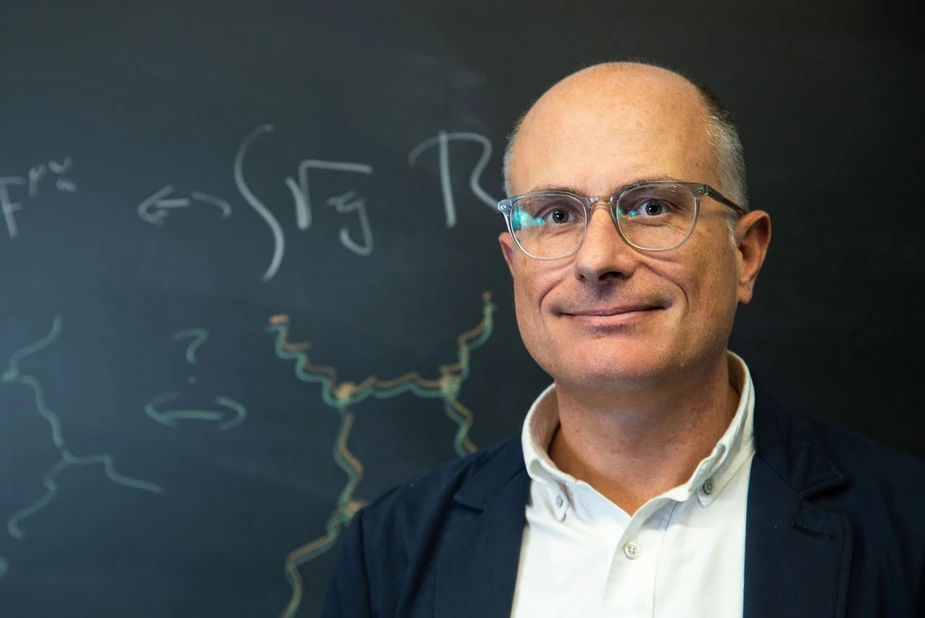Prof. Jan Plefka receives ERC Advanced Grant
European Research Counsil stellt 2,2 Mio. Euro für das Projekt GraWFTy zur Forschungen in der Gravitationswellenphysik zur Verfügung
Jan Plefka receives a prestigious Advanced Grant from the European Research Council (ERC). He and his team at the Department of Physics and IRIS Adlershof of HU Berlin will receive 2.2 million euros over the next five years for the GraWFTy project (High-Precision Gravitational Wave Physics from a Worldline Quantum Field Theory) to describe gravitational waves using quantum field theory. The predictions made possible in this way are needed for the wave detectors of the next generation to go online in the 2030s.
The ERC Advanced Grant
ERC Advanced Grants are endowed with up to 2.5 million euros and support excellent and self-initiated research projects of leading top researchers. It is the most highly endowed European research grant. The awardees are exceptional leaders who distinguish themselves through the originality and significance of their approaches.
About the awardee
Professor Jan Plefka is a renowned theoretical physicist and professor at Humboldt-Universität zu Berlin. After studying physics and receiving his PhD from the University of Hannover in 1996, he was a postdoctoral researcher in New York, Amsterdam, and at the MPI Potsdam. He was a visiting professor at ETH Zurich and at CERN. His research is concerned with quantum field theory and its relation to gravity. Here, he made important contributions to questions of quantum gravity and string theory, in particular in the area of AdS/CFT correspondence and hidden symmetries in supersymmetric quantum field theories. More recently, he has developed together with his group an innovative quantum field theoretical formalism to answer questions in classical gravitational wave physics. The ERC Advanced Grant was awarded to him to fully unfold the potential of this quantum approach to classical physics. He is the spokesperson of the DFG Research Training Group 2575, "Rethinking Quantum Field Theory." Jan Plefka has received several awards, including a Feodor Lynen Fellowship from the Humboldt Foundation and the Lichtenberg Professorship from the Volkswagen Foundation.
The GraWFTy Projekt: High-Precision Gravitational Wave Physics from a Worldline Quantum Field Theory
Gravitational waves are tiny ripples of the space-time fabric that travel through our universe at the speed of light. They arise as soon as masses are accelerated. They are a direct prediction of Einstein's theory of relativity, which he established during his fruitful Berlin years as early as 1916. They were first directly detected only 100 years later in 2015 with the LIGO detector, emerging from a merger of two black holes and after a journey of billions of light years through our universe to us. There are currently three gravitational wave observatories in operation: LIGO, Virgo, and Kagra. They routinely detect gravitational waves emanating from such mergers of black holes and neutron stars. To date, about 90 such events have been detected. In the 2030s, a new generation of ground- and space-based gravitational wave detectors will come on-line that will significantly increase the sensitivities of these measurements. To match these sensitivities, theoretical physics must predict highly accurate waveforms from Einstein's theory that greatly exceed the current state of the art. The GraWFTy project will provide these predictions for the high-precision form of gravitational waves. With their help, fundamental questions in physics will be studied:
- Is Einstein's theory correct in the strong gravitational field regime?
- How are black holes formed, what is their population in the universe?
- Can we see signals for physics beyond the known natural forces and particles?
Jan Plefka explains his approach: “Together with my research group, we have been able to develop an innovative method since 2020 that addresses this problem of classical physics using methods from quantum field theory. Quantum field theory is the mathematical description of elementary particle physics, that is the smallest building blocks of our universe and their interactions. It is exceedingly fascinating that this language can also be applied to classical gravitational physics with high efficiency. In short, we replace the scattering of protons, as it happens in accelerators like the LHC at CERN, in our formalism by the scattering of black holes or neutron stars. There is, of course, the initial simplification that we can now neglect the quantum effects in the extensive calculations – which in the case of gravity are also still ill understood. Yet, this simplification is compensated by the complexity of Einstein's theory compared to the standard model of elementary particle physics relevant to proton scatterings.
The great advantage of our so-called "world-line" approach is that we can directly target the observable quantities in the detector, using the modern mathematical technology of quantum field theory, namely Feynman integrals. Another peculiar aspect of our approach is that the spin of black holes is described by a supersymmetry. Its existence has been speculated so far in elementary particle physics. We could show that it appears in the effective description of rotating black holes. The idea for this approach comes from string theory. For me, this project represents a crucial step in my career.
So far, I have focused my research primarily on the question of quantum gravity and its relation to gauge field theories. This was primarily mathematical physics and far away from direct measurements. With GraWFTy, I am now applying these ideas priorly developed in an abstract setting to pressing, to pressing questions in gravitational wave physics. We have already been able to prove the efficiency of this approach. The ERC Advanced Grant will allow me to fully unfold the potential of our approach.”
Contact
Prof. Dr. Jan Christoph Plefka
Department of Physics and IRIS Adlershof
Humboldt-Universität zu Berlin
Zum Großen Windkanal 2, 12489 Berlin
jan.plefka(at)physik.hu-berlin.de
Press release IRIS Adlershof, 30 March 2023
